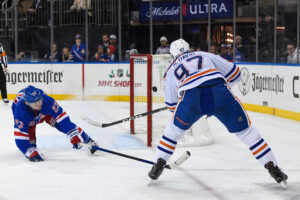Main Photo: Geoff Burke-USA TODAY Sports
NHL player development seems to always result in more questions than answers. How likely is it for a top pick to pan out? What makes a player a “steal”? Last Word On Hockey will be starting a new series on how to properly develop prospects from all different spots throughout the draft. With forwards drafted out of North American hockey leagues between 2005 and 2015, in the first round, covered, let’s shift to forwards drafted out of Europe.
NHL Player Development Of Top-Three Picks
In the span of 2005 through 2015, there was one player selected within the top-three out of Europe. That player was Aleksander Barkov. Barkov made his NHL debut immediately following the draft, in his DY+1 season.
In these pieces, Last Word will be using Even-Strength Offence Goals Above Replacement (EVO), Even-Strength Defence Goals Above Replacement (EVD), Wins Above Replacement (WAR) and Goals Above Replacement (GAR). All those analytics come from Evolving-Hockey (paid subscription required).
NHL Player Development Of Aleksander Barkov
Aleksander Barkov, drafted second overall in the 2013 NHL draft by the Florida Panthers, came out of the SM-Liiga’s Tappara organization. In his DY-1 season, as a 16/17-year-old, he played 32 SM-Liiga games, scoring seven goals and nine assists for 16 points, for 0.5 points per game. He followed that up with 21 goals and 27 assists for 48 points in 53 games, for 0.906 points per game. With two successful seasons in the Finnish top men’s league, Barkov immediately made the transition to Florida’s NHL club.
How Barkov Was Used
As a rookie, Barkov played 54 games with the Panthers, while averaging 17:06 time on ice per game. With a solid role, essentially a second-line role, Barkov scored eight goals and 16 assists for 24 points, which is respectable. According to elite prospects, he ranked 16th in Calder Trophy voting. While his raw stats weren’t eye-popping, his analytics showed underlying potential. His EVO (3.6) and EVD (2.7) were very solid, especially his EVD. Meanwhile, his WAR (1.3) was very good for a rookie, and his GAR (6.8) was also strong.
The following year, Barkov would play more games with 71, and averaged 17:30 per game. Playing essentially the same role, Barkov would go on to score 16 goals and 20 assists for 36 points, another modest statline. But this time, his analytics regressed. His EVO (0.3) was not great, and his EVD (1.8) remained strong, but took a small step back. With the small step back, his WAR (0.7) dropped alongside his GAR (3.7).
Barkov’s Year Three Breakout
Going into his third season with back-to-back decent, but not great seasons. Barkov and the Panthers would find a solution. Playing in 66 games, he would average 19:26 per game, a massive raise from the first two seasons. With that, Barkov would reward the Panthers with 28 goals and 31 assists for 59 points. Almost every analytic made a huge jump up. Only his EVD (-0.5) took a step back, and a noticeable one at that. But his EVO (9.7) leaped towards elite status, while his WAR (2.6) and GAR (13.6) did the same.
Following that exceptional season, in 2015-16, Barkov would extend with the Panthers and remains with the team today. That’s despite all the changes this past off-season, where teammates Jonathan Huberdeau and MacKenzie Weegar were traded to the Calgary Flames. Since that third year, he has played 454 games and counting with Florida, scoring 184 goals and 300 assists for 484 points. Barkov has won a Lady Byng trophy (2018-19) and a Selke trophy (2020-21) in his career. He currently makes $10,000,000 per season on his current contract. It’s safe to say that the Panthers NHL player development of Aleksander Barkov went just fine.
Junior league stats via Elite Prospects, NHL stats via Hockey Reference, NHL analytics via Evolving Hocke






